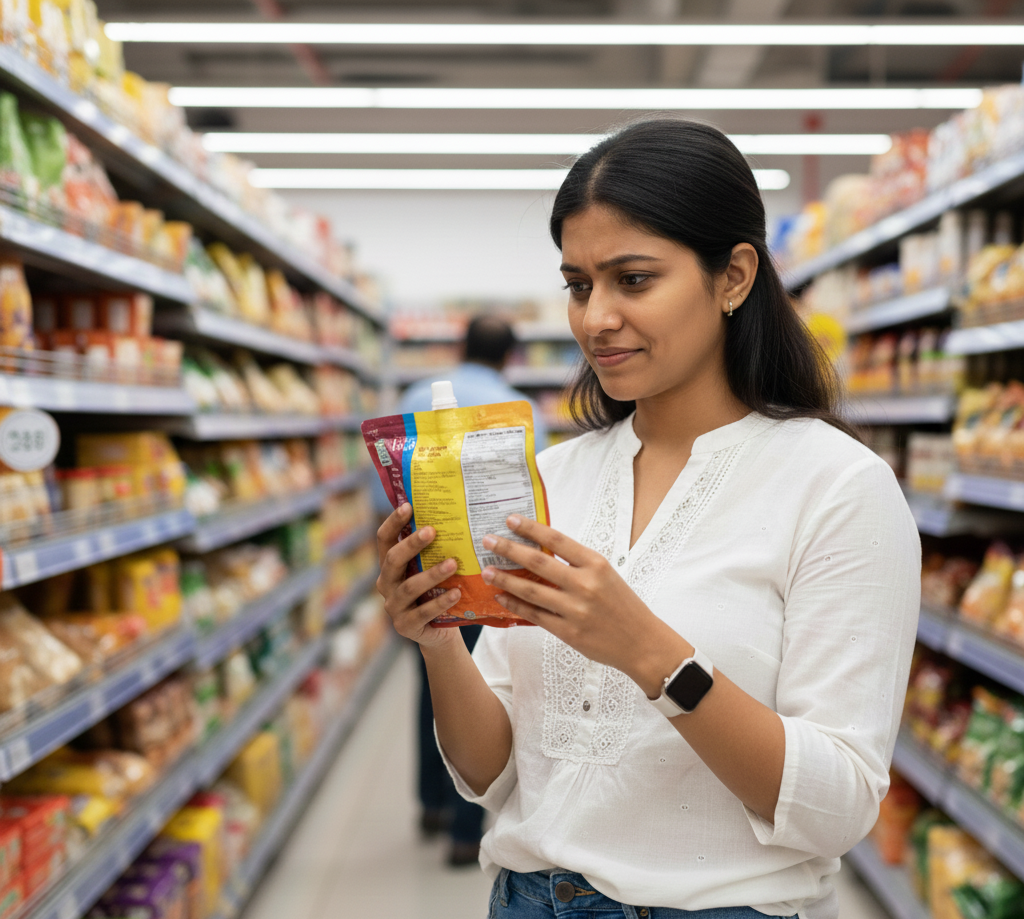Every parent wants to choose safe, nutritious food for their baby — but food labels can be confusing. In this guide, we’ll walk through the basics of reading baby food labels so you can choose with confidence.
For growing babies, you want foods that are: clean, easy to digest, made from real ingredients, and free from hidden sugars, preservatives, or artificial flavours. The real truth is always in the ingredient list and the nutrition table.
1. Start With the Ingredient List (Not the Nutrition Table)
The ingredient list is always shown in descending order — the first ingredient is used the most. This is the best place to see what your baby is actually eating.
What you want to see:
- Simple real ingredients
- Names you easily recognise (grains, fruits, nuts, seeds)
- No complicated chemical terms
- No unnamed “mixes” or “blends” that hide the real ingredients
Example of a clean ingredient list: Sprouted ragi, red banana powder, dates powder, cardamom.
Red flags:
- Sugar, sucrose, maltodextrin, fructose
- Corn starch or wheat starch as cheap fillers
- Artificial flavours or “nature-identical” flavours
- Added colours
- Vegetable oils that aren’t clearly named
- Very long ingredient lists full of words you can’t pronounce
2. Watch Out for Hidden Sugar
Even if a label says “No Added Sugar”, sugar can still appear under other names. For babies under 2 years, it’s best to avoid added sugar completely.
Common hidden sugar names:
- Maltodextrin
- Glucose syrup solids
- Dextrose
- Malt extract
- Fructose syrup
- Caramel
- Fruit juice concentrate
Natural sweeteners like dates powder are a much better choice than refined sugar in baby foods.
3. Check for Preservatives and Artificial Additives
Many commercial mixes use preservatives and artificial flavours to extend shelf life or improve taste. For babies, it’s safest to avoid them wherever possible.
Common preservatives in baby foods:
- Potassium sorbate
- Sodium benzoate
- Added citric acid
Look for clear statements such as: “No preservatives”, “No artificial colours”, “No artificial flavours”, “No thickeners”. If it’s not mentioned anywhere, there is a good chance additives are being used.
4. Check Protein, Iron and Fibre
For babies and kids, three key nutrients to watch on the label are: protein, iron and fibre.
If these numbers are very low, the product may be mostly starch or fillers with little real nutrition.
5. Be Careful with “Fortified With…” Claims
Fortification itself is not bad, but it is often used to make highly processed foods look healthy. For example, a cereal made from refined flour may add synthetic iron and vitamins just to pass as “nutritious”.
For babies, natural nutrition is always better than synthetic additives. Look for foods that are naturally rich in nutrients, such as:
- Millets like ragi
- Dates and red banana
- Pulses and lentils
- Nuts and seeds
6. Understand Serving Size and Preparation Instructions
Different brands show nutrition values per 10 g, per serving, or per 100 g. For comparison, always look at the per 100 g column.
Red flags in preparation instructions:
- “Add sugar” or “sweeten to taste” for babies
- Very high flame or very long cooking times
- Instructions to mix directly with cold water for small babies
Safer products usually have simple instructions: mix with hot water or milk, cook briefly, and serve warm.
7. Look for Allergen Information
If your baby has allergies or a family history of sensitivities, allergen labelling becomes very important.
Check for statements such as:
- “Contains nuts”
- “Contains wheat / gluten / soy”
- “Manufactured in a facility that processes nuts, wheat or soy”
This helps you choose products that are safer for your baby’s unique needs.
8. Be Wary of “Natural Flavours”
The term “natural flavour” sounds safe but can still refer to processed flavouring substances. In baby foods, the taste should come from real ingredients, not flavour chemicals.
When you see “natural flavour” listed but no real fruit or spice, it’s a sign the product may be highly processed.
9. Check the Packaging Date and Shelf Life
Always check the manufacturing date and choose the newest batch available.
Smaller-batch brands and airtight packaging usually mean fresher, more flavourful food for your baby.
10. Don’t Get Misled by Marketing Words
Many labels use words that sound healthy but don’t have any strict definition. It’s easy to get carried away by the front of the pack and forget to read the back.
Common examples:
- “Made with real fruits” — sometimes only 2–3% fruit
- “Rich in iron” — but from synthetic fortification
- “No maida” — but still full of starch fillers
- “Energy drink” — often mostly sugar
Instead of focusing on these claims, always come back to the basics: short ingredient list, clean ingredients, no additives, and good protein, iron and fibre values.
Quick Checklist for Choosing a Baby Food
Before you put a product into your cart, ask yourself:
- Are all the ingredients real and easy to understand?
- Is there no added sugar, preservatives or artificial flavours?
- Is it made from nutrient-dense foods like millets, pulses, fruits or nuts?
- Do the protein, iron and fibre values look strong for a baby food?
- Are the preparation instructions safe and simple?
If the answer is “yes” to most of these, you’re probably holding a good, baby-friendly product.
Live Indianly’s Promise of Transparency
At Live Indianly, we believe parents deserve complete honesty about what goes into their baby’s bowl. Our mixes are made with a short list of clean, real ingredients — with no maida, no preservatives, no artificial flavours and no added sugar.
We keep our labels simple so you can read them in seconds and feel confident about every scoop. Because your baby deserves only real, honest nutrition.





